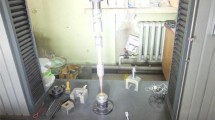Abstract
In this paper, we propose an experimental and numerical model to study the creep behavior of the unidirectional Alfa fiber composite strength by the photoelasticity method. To have better mechanical properties, chemical treatment is made for Alfa fibers. Tensile tests are made to predict the Young modulus and tensile strength. These tests confirm that the chemical treatment during 48 Hours of Alfa fibers collected from the south region gives the best results. After that, specimens are made in Medapoxy STR resin and treated Alfa fibers of the south region. All fibers of specimens are arranged approximately in multiple hexagonal clusters embedded in the matrix. For the micromechanical fiber stress redistribution or load sharing theory to be applied, clusters must minimally contain one broken fiber. Consequently, we have a stress perturbation due to a fiber fracture, which propagates to the nearest-neighbor fibers. This perturbation enables us the photoelastic visualization of the fracture events during the creep tests. The contour diagram and fringe values give us the accurate distribution of stress near broken fibers showing local shear stress concentrations during the time. To simulate the creep response and failure mechanism, the Tsai–Wu failure criterion was applied on ANSYS explicit dynamic software. Because it merges between experimental tests and numerical simulation, the present study offers a real scientific contribution in the creep behavior of biobased composite strength by the photoelasticity method.
















Similar content being viewed by others
References
Beyerlein, I.J., Phoenix, S.L., Raj, R.: Time evolution of stress redistribution around multiple fiber breaks in a composite with viscous and viscoelastic matrices. Int. J. Solids Struct. 35(24), 3177–3211 (1998)
Bouhamida, B., Sereir, Z., Chateauneuf, A.: Uncertainties of stress intensification near broken fibers of unidirectional composite with random fiber spacing. Theor. Appl. Fract. Mech. 65, 1–7 (2013)
Bouhamida, B., Sereir, Z., Chateauneuf, A.: Analytical model of the longitudinal break of a unidirectional composite with natural fibers. Rev. Compos. Mater. Av. 26(3–4), 401–417 (2016)
Endo, V.T., de Carvalho Pereira, J.C.: Linear orthotropic viscoelasticity model for fiber reinforced thermoplastic material based on Prony series. Mech. Time-Depend. Mater. 21, 199–221 (2017)
Flores-Johnson, E.A., Vázquez-Rodríguez, J.M., Herrera-Franco, P.J., González-Chi, P.I.: Photoelastic evaluation of fiber surface-treatments on the interfacial performance of a polyester fiber/epoxy model composite. Composites, Part A, Appl. Sci. Manuf. 42, 1017–1024 (2011)
Guedes, R.M.: Cumulative creep damage for unidirectional composites under step loading. Mech. Time-Depend. Mater. 16, 381–396 (2012)
Hao, W., Zhu, J., Zhu, Q., Yuan, Y.: Photoelastic analysis of matrix crack-tilted fiber bundle interaction. Polym. Test. 51, 101–108 (2016)
Helaili, S., Chafra, M.: Anisotropic visco-elastic properties identification of a natural biodegradable ALFA fiber composite. J. Compos. Mater. 48(13), 1645–1658 (2013)
Khaldi, M., Vivet, A., Bourmaud, A., Sereir, Z., Kada, B.: Damage analysis of composites reinforced with Alfa fibers: viscoelastic behavior and debonding at the fiber/matrix interface. J. Appl. Polym. Sci. 133(31), 43760 (2016)
Khiat, M.A., Sereir, Z., Chateauneuf, A.: Uncertainties of unidirectional composite strength under tensile loading and variation of environmental condition. Theor. Appl. Fract. Mech. 56(3), 169–179 (2011)
Kotelnikova-Weiler, N., Baverel, O., Ducoulombier, N., Caron, J.F.: Progressive damage of a unidirectional composite with a viscoelastic matrix, observations and modelling. Compos. Struct. 188, 297–312 (2018)
Koyanagi, J., Nakada, M., Miyano, Y.: Tensile strength at elevated temperature and its applicability as an accelerated testing methodology for unidirectional composites. Mech. Time-Depend. Mater. 16, 19–30 (2012)
Melo, J-D.D., de Medeiros, A.M.: Long-term creep-rupture failure envelope of epoxy. Mech. Time-Depend. Mater. 16, 113–121 (2014)
Muliana, A., Li, K.A.: Time-dependent response of active composites with thermal, electrical, and mechanical coupling effect. Int. J. Eng. Sci. 48, 1481–1497 (2010)
Ohno, N., Miyake, T.: Stress relaxation in broken fibers in unidirectional composites: modeling and application to creep rupture analysis. Int. J. Plast. 15, 167–189 (1999)
Ohno, N., Ando, T., Miyake, T., Biwa, S.: A variational method for unidirectional fiber-reinforced composites with creep matrix. Int. J. Solids Struct. 39, 159–174 (2002)
Ramirez, F.A., Carlsson, L.A., Acha, B.A.: A method to measure fracture toughness of the fiber/matrix interface using the single-fiber fragmentation test. Composites, Part A, Appl. Sci. Manuf. 40(6–7), 679–686 (2009)
Vázquez-Rodríguez, J.M., Flores-Johnson, E.A., Herrera-Franco, P.J., Gonzalez-Chi, P.I.: Photoelastic and numerical analyses of the stress distribution around a fiber in a pull-out test for a thermoplastic fiber/epoxy resin composite. Polym. Compos. 39, E2397–E2406 (2018)
Zhao, F.M., Patterson, E.A., Jones, F.R.: Phase-stepping photoelasticity for quantifying the interfacial response in fibre composites at fibre-breaks. Mater. Sci. Eng. A 412, 83–87 (2005)
Zhao, F.M., Hayes, S.A., Patterson, E.A., Jones, F.R.: Phase-stepping photoelasticity for the measurement of interfacial shear stress in single fibre composites. Composites, Part A, Appl. Sci. Manuf. 37(2), 216–221 (2006)
Zhao, F.M., Liu, Z., Jones, F.R.: Photoelastic determination of interfacial shear stresses in model composites. Key Eng. Mater. 334–335, 289–292 (2007)
Author information
Authors and Affiliations
Corresponding author
Additional information
Publisher’s Note
Springer Nature remains neutral with regard to jurisdictional claims in published maps and institutional affiliations.
Rights and permissions
About this article
Cite this article
Berrekheroukh, N., Sereir, Z., Vivet, A. et al. Experimental and numerical models to study the creep behavior of the unidirectional Alfa fiber composite strength by the photoelasticity method. Mech Time-Depend Mater 26, 547–564 (2022). https://doi.org/10.1007/s11043-021-09500-5
Received:
Accepted:
Published:
Issue Date:
DOI: https://doi.org/10.1007/s11043-021-09500-5




